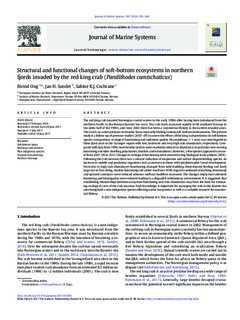| dc.contributor.author | Oug, Eivind | |
| dc.contributor.author | Sundet, Jan Henry | |
| dc.contributor.author | Cochrane, Sabine K.J. | |
| dc.date.accessioned | 2018-09-10T09:16:13Z | |
| dc.date.available | 2018-09-10T09:16:13Z | |
| dc.date.created | 2018-07-04T11:07:43Z | |
| dc.date.issued | 2018 | |
| dc.identifier.citation | Journal of Marine Systems. 2018, 180 255-264. | nb_NO |
| dc.identifier.issn | 0924-7963 | |
| dc.identifier.uri | http://hdl.handle.net/11250/2561677 | |
| dc.description.abstract | The red king crab invaded Norwegian coastal waters in the early 1990s after having been introduced from the northern Pacific to the Russian Barents Sea coast. The crab stock increased rapidly in NE northern Norway in the latter half of the 1990s, and since 2002 there has been a commercial fishery in the eastern invaded areas. The crab is an active predator on benthic fauna especially feeding in deep soft-bottom environments. The present study is a follow-up of previous studies (2007–09) to assess the effects of the king crab predation on soft bottom species composition, ecological functioning and sediment quality. Macroinfauna (> 1 mm) was investigated in three fjord areas in the Varanger region with low, moderate and very high crab abundances, respectively. Compared with data from 1994, most benthic species were markedly reduced in abundance, in particular non-moving burrowing and tube-dwelling polychaetes, bivalves and echinoderms. However, a few species appeared to recover from 2007–09 to 2012. Changes in ecological functioning were assessed using ‘biological traits analysis (BTA)’. Following the crab invasion there was a relative reduction of suspension and surface deposit feeding species, an increase in mobile and predatory organisms and an increase in those with planktotrophic larval development. From low to high crab abundances functioning changed from tube-building, deep deposit feeding and fairly large size to free-living, shallow burrowing and rather small size. With regard to sediment reworking, downward and upward conveyors were reduced whereas surficial modifiers increased. The changes imply that sediment biomixing and bioirrigation were reduced leading to a degraded sedimentary environment. It is suggested that establishing relationships between ecosystem functioning and crab abundances may form the basis for estimating ecological costs of the crab invasion. Such knowledge is important for managing the crab in the Barents Sea area being both a non-indigenous species affecting native ecosystems as well as a valuable resource for commercial fishery. | nb_NO |
| dc.language.iso | eng | nb_NO |
| dc.title | Structural and functional changes of soft-bottom ecosystems in northern fjords invaded by the red king crab (Paralithodes camtschaticus) | nb_NO |
| dc.title.alternative | Structural and functional changes of soft-bottom ecosystems in northern fjords invaded by the red king crab (Paralithodes camtschaticus) | nb_NO |
| dc.type | Journal article | nb_NO |
| dc.type | Peer reviewed | nb_NO |
| dc.description.version | publishedVersion | nb_NO |
| dc.source.pagenumber | 255-264 | nb_NO |
| dc.source.volume | 180 | nb_NO |
| dc.source.journal | Journal of Marine Systems | nb_NO |
| dc.identifier.doi | 10.1016/j.jmarsys.2017.07.005 | |
| dc.identifier.cristin | 1595578 | |
| cristin.unitcode | 7431,12,0,0 | |
| cristin.unitname | Bentiske ressurser og prosesser | |
| cristin.ispublished | true | |
| cristin.fulltext | original | |
| cristin.qualitycode | 1 | |
